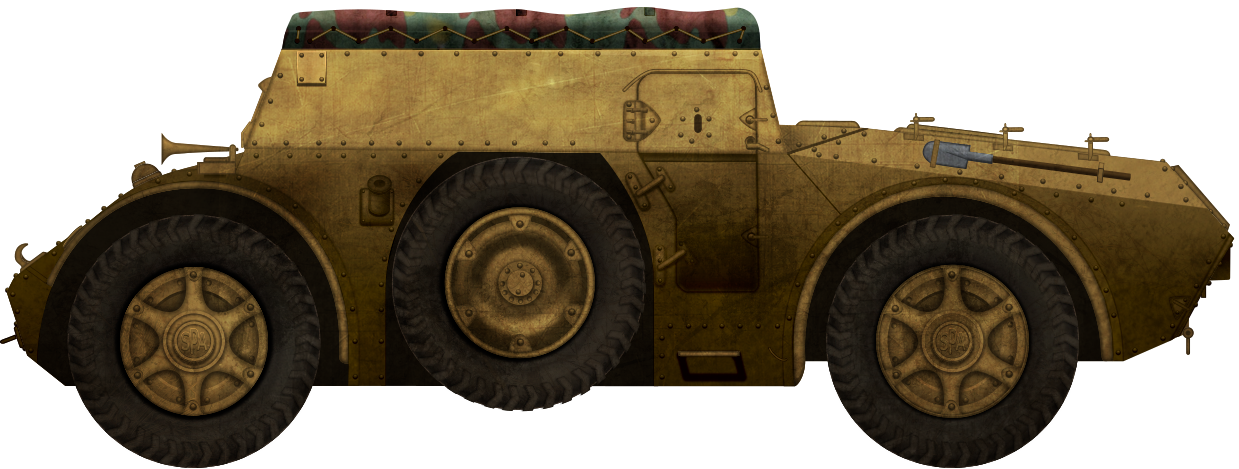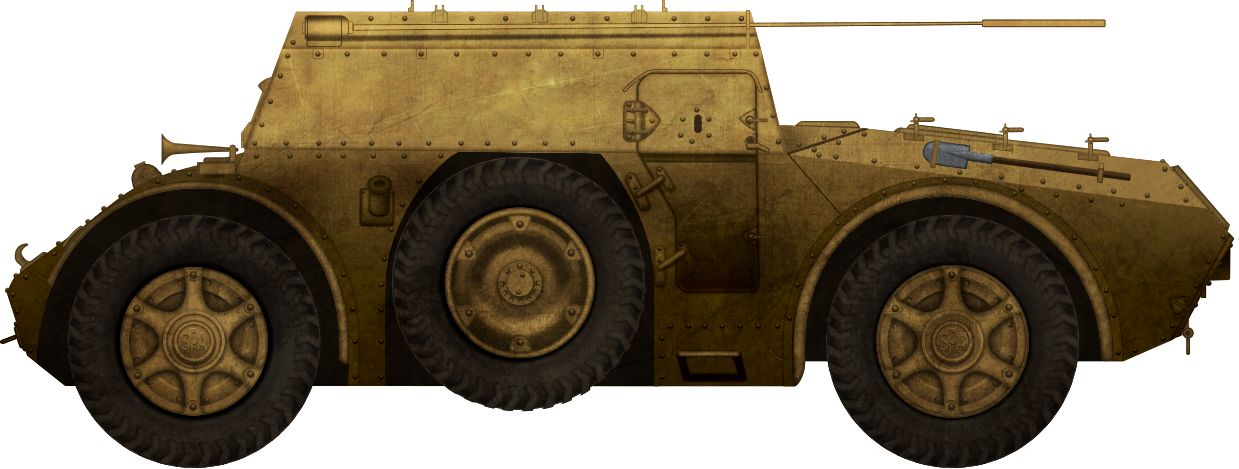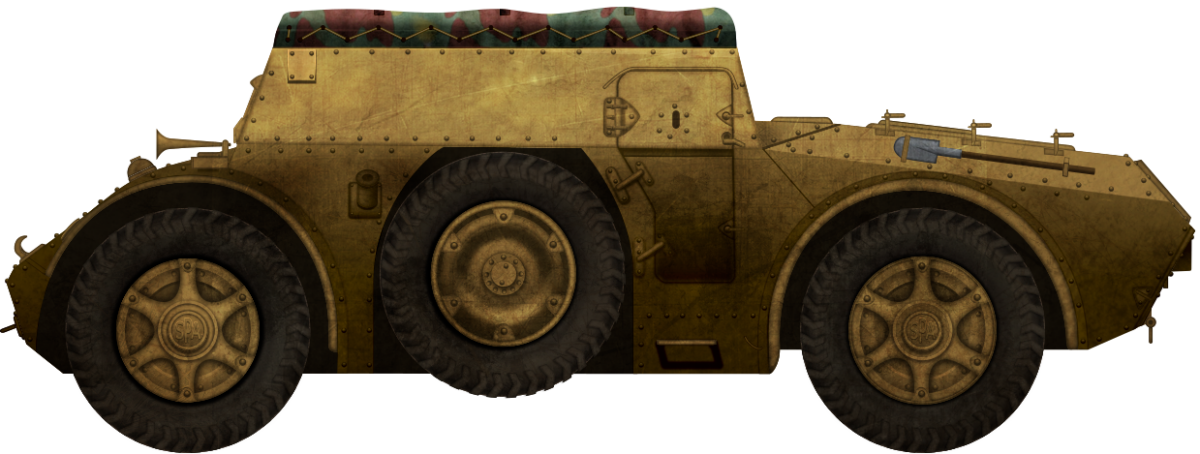 Kingdom of Italy (1941-1942)
Kingdom of Italy (1941-1942)
Ammunition Carrier – 5 Built
The Autoblindo AB41 Trasporto Munizionic (English: AB41 Armored Car [based] Ammunition Carrier) was an Italian ammunition carrier built on the chassis of the AB armored car series, the most produced Italian armored car during the Second World War. A total number of 5 older AB40 were modified by the Ansaldo-Fossati plant in Sestri Ponente into ammunition carriers, but it seems that they were never delivered to the Italian units in the frontline.

The Autoblindo Modello 1940
The first vehicle of the AB series, the Autoblindo Modello 1940 (English: Model 1940 Armored Car), or simply AB40, was developed as a successor to the Lancia 1ZM, a First Word War era Italian armored car.
The Italian Army made a request for a new armored car with similar characteristics to the Lancia. At the same time, the Polizia dell’Africa Italiana or PAI (English: Police of Italian Africa), the police corps tasked with keeping order in the Italian colonies in Africa, also ordered a similar vehicle to patrol the colonies.
The Fabbrica Italiana Automobili di Torino or FIAT (English: Italian Automobile Factory of Turin) and Ansaldo of Genoa started a joint development to meet these requirements. To speed up production and save money, they produced a vehicle that could satisfy both requests simultaneously, and in 1938, the first prototype was ready. It was initially called Autoblindomitragliatrice Modello 1940 (English: Machine Gun Armored Car Model 1940).

The AB40 maintained the same armament distribution as the Lancia 1ZM, with two medium machine guns in the turret and a third in the rear of the hull. All the machine guns were 8 mm Breda Modello 1938. Apart from that, it had a totally new shape and two driving seats, one at the front and one at the back. This would permit the crew to quickly disengage from firefights.

With the experiences gained by the Italians during the Spanish Civil War, during which the opposing Republican forces were equipped with BA-6 heavy armored cars, T-26 and BT-5 light tanks, all armed with 45 mm guns, the Italian High Command understood that two machine guns were not enough to deal with enemy vehicles.

Because of the lack of firepower, only 24 AB40s were produced in 1941, before being improved with a new turret armed with a Cannone-Mitragliera Breda da 20/65 Modello 1935 20 mm automatic cannon. This new version also received a more powerful engine that delivered 88 hp instead of the previous 78 hp (although a number of vehicles were fitted with both the new turret and the old engine). This new version was renamed Autoblindo Modello 1941.
Accepted into service, the production of the pre-series vehicles started. In March 1941, a total of 5 other pre-series AB40 were ready, and on 20th March 1941, they were delivered to the Scuola di Cavalleria (English: Cavalry School) of Pinerolo, in the Centro Addestramento Autoblindo (English: Armored Car Training Center). The 5 vehicles received license plates: Ro. Eto. 117B, Ro. Eto. 118B, Ro. Eto. 119B, Ro. Eto. 120B and Ro. Eto. 121B.

History of the Vehicles
It is not clear exactly for how long the 5 pre-series vehicles remained in Pinerolo for training purposes, but they were used extensively to train crews.


As the war progressed, the 5 AB40s deployed at Pinerolo were substituted by more powerful AB41s, which was the standard vehicle in the theaters of war.
The 5 pre-series AB40s produced in early 1941 were sent back to the Ansaldo-Fossati plant in Sestri Ponente. They received a thorough inspection and overhaul, during which worn parts were replaced with new ones.

The Regio Esercito units often complained, especially the divisions deployed in North Africa, about the little amount of ammunition transported inside armored cars, tanks, and other armored vehicles. This forced individual vehicles to retreat to replenish ammunition during clashes with the Allies, before returning to the battlefield. This slowed down any offensive, weakened the Italian line, and could create serious problems if the vehicles could not be reloaded with ammunition.
Infantry divisions also complained about the lack of dedicated ammunition carriers for their artillery units. The few ammunition carriers available were simple cargo trucks that were very vulnerable to light enemy fire. This was exemplified during the first actions in North Africa, where captured Commonwealth lorries were modified into ammunition carriers.
Another way to protect ammunition carriers was to place a light anti-aircraft gun or 47 mm support gun on the cargo bays of heavy duty trucks, which had enough space to additionally load the crewmembers and a considerable ammunition supply.
It is not clear when or who came up with the idea to convert the obsolete Autoblinde AB40 into ammunition carriers. It is likely that Ansaldo initiated it on its own accord, but nothing to verify this has been found in the Ansaldo archives nor the Army’s archives. The images of the Autoblindo AB41 Trasporto Munizioni show a single AB40 converted into an ammunition carrier, so it is difficult to confirm if all the 5 pre-series AB40s were modified.
It seems that the Autoblindo AB41 Trasporto Munizioni, however many were built, were never deployed to the field, probably because Ansaldo never received orders from the Regio Esercito on where to send them or to which unit to deliver them to. As a result, it is likely that the vehicles were used by Ansaldo to transport ammunition or materials within the perimeter of the Ansaldo-Fossati plant, were repurposed into something else after the project failed, or scrapped for spare parts.
The Autoblinda AB42 Comando and the Semovente 47/32 su Scafo AB41 were built on the same chassis as the AB41 Trasporto Munizioni and could have also been produced starting from one of the 5 pre-series AB40 chassis.
Design
The question of the name remains a clue. The vehicles were called Autoblindo AB41 Trasporto Munizioni even though they were modified from Autoblindo AB40 armored cars.
This was probably because the modifications to convert the obsolete armored cars into ammunition carriers started in 1941. This was also made for the Autoblinda AB42 Comando that was built from a pre-existing pre-series AB40.
By analyzing the Italian industry’s capabilities at that time, maybe the decision not to adopt the armored car’s chassis for ammunition transport was a good one. The AB armored car series already had a slow rate of production in its standard fighting variant. Another variant built on its chassis would have deprived the Italian divisions on the frontlines of precious reconnaissance armored cars.
Modifications
The turret and armored roof were removed on the ammunition carrier version of the AB40. Some armored plates, probably 8.5 mm thick, were bolted on the sides to raise the sides of the superstructure increasing the internal volume of the vehicle. To protect the crew from the elements, there was a removable waterproof tarpaulin. The open topped solution was a useful one to reload armored vehicles, as the Autoblindo AB41 Trasporto Munizioni’s crew could easily pass the 20 mm clips or the 47 mm rounds to the crews of armored vehicles who remained safely inside their vehicles.
The rear driving position was removed on the Autoblindo AB41 Trasporto Munizioni. Due to the new tasks the vehicle had to perform, it was not as necessary to retract quickly from battlefields. Instead, it was important to carry as much ammunition as possible.
The vision slot that permitted the rear driver to check the battlefield was removed and the hole was covered by a rectangular armored plate bolted onto the rear armored plate. The rear Breda Modello 1938 machine gun’s spherical support was also removed, as the vehicle no longer needed offensive armament in its new role. The hole was once more covered by a rounded armored plate bolted onto the vehicle’s superstructure. It is not known if the rounded armored plate was equipped with a pistol port closed by a revolving shutter from the inside like the side doors. The Autoblinda AB42 Comando, a vehicle modified in a similar way, received a pistol port on the rear to permit the crew to defend themselves from enemy infantry attacks.

The interior sides of the vehicles were totally changed. All the ammunition racks for the Breda machine guns were removed, together with the radio apparatus and the antenna, on the left side. Instead, wooden racks to store 20 mm and 47 mm rounds were added. Unfortunately, it is not known exactly how nor how much ammunition was stored inside the Autoblindo AB41 Trasporto Munizioni.
At an unknown date, a single Autoblinda AB42 Comando was produced by the Centro Studi della Motorizzazione. After testing, it was sent to the Ansaldo-Fossati plant in Sestri Ponente, where the Regio Esercito’s High Command planned that Ansaldo would start production. Production never started, but it seems that Ansaldo produced a prototype of the AB42 Comando on another chassis. To save money, they perhaps converted one of the 5 pre-series AB40s into this second prototype of the command vehicle.

The crew on the Autoblindo AB41 Trasporto Munizioni consisted of two: a driver sat in the front and a commander, whose exact position is not clear. The crew could rely on the side’s pistol ports and probably a third one on the rear to use their personal weapons. It seems plausible that the vehicles would have been equipped with an anti-aircraft machine gun support, probably for a Breda Modello 1938 medium machine gun.
Armor
The armor on the entire hull and superstructure consisted of bolted plates. This arrangement did not offer the same efficiency as a mechanically welded plate, but facilitated the replacement of an armor element in case it had to be repaired.
The armored plates of the prototype were left unchanged on the Autoblindo AB41 Trasporto Munizioni. The hull had 8.5 mm thick armored plates on the front, sides, and rear. The wheel fenders were also armored to prevent enemy fire from piercing the tires.
In general, the armor was more than adequate for the original armored car role and its ammunition carrier version, protecting the crew from enemy infantry’s light weapons.

Hull
The hull of the armored car had an internal structure on which the plates were bolted. At the rear of the superstructure, there were the two armored access doors, divided into two parts, that could be opened separately. The upper part had a pistol port closed by a revolving shutter, inside so that the crew could use their personal weapons for close-quarters defense. On the left was the antenna, which rested on a support at the back of the superstructure. In fact, in order to open the upper part of the left door, it was necessary to raise the antenna by a few degrees.

On the right, the horn was placed at the front, a pickaxe was placed on the side, and the exhaust pipe was placed on the rear mudguard. The two spare wheels were placed in two fairings on the sides of the superstructure. Above the engine compartment, there were two air intakes and two hatches for engine maintenance. On the back were the cooling grille and the two rear lights with the license plate.
Engine and Suspension
The Autoblindo AB41 Trasporto Munizioni’s engine was a FIAT-SPA ABM 1, 6-cylinder water-cooled inline petrol engine with an internal volume of 4,995 cm3. It delivered a maximum output of 78 hp (some sources claim 80 hp) at 2,700 rpm.
It was cooled by a water circuit driven by a centrifugal pump. The engine’s cooling water tank was placed under the rear driver’s hatch, on the left of the fuel reserve tank, even if the rear driver position was removed. The engine was coupled with a Zenith type 42 TTVP carburetor housed in the back of the engine compartment.

The engine could be started manually using a crank or electrically with an ignition key. The single dry plate clutch transmitted the movement of the drive shaft to a gearbox. The differential, from which the four drive shafts departed, was in the center of the vehicle and connected to the propeller shaft on the rear.
The engine compartment was well cooled with grilles on the engine deck, right behind the rear armored plate of the superstructure, grilles on the maintenance hatches, and inclined grilles on the rear for the radiator’s water cooling. It should also be considered that the lack of a bulkhead allowed for easier cooling.
The engines were designed by FIAT and produced by its subsidiary, Società Piemontese Automobili or SPA (English: Piedmontese Automobiles Company), in Turin.
There were two fuel tanks with a total capacity of 138 l. The main one, with 118 l, was in the double bottom of the floor, while the 20 l reserve tank was placed on the rear armored plate, in the rear of the crew compartment. The oil bath air filters were of satisfactory quality, giving great results even in the desert environment.

The electrical system was composed of a Magneti Marelli 3 MF15 battery with 4 accumulators and was used to power the 4 external headlights, radios, and the horn placed on the front right mudguard.
The suspension was a four-wheel drive and four steering wheels with independent shock absorbers on each wheel which, coupled with the large diameter tires, gave excellent off-road mobility to the armored cars.

The Turretless AB41 in North Africa
During the North African Campaign, it seems that at least one AB41, probably damaged during combat with the Allies, was modified by removing the turret. It was likely initially used as a liaison vehicle or as an ammunition carrier vehicle, i.e. what the Autoblindo AB41 Trasporto Munizioni was meant to perform. Nothing more is known about it.

Conclusion
The Autoblindo AB41 Trasporto Munizioni was a cheap conversion of the obsolete AB40. They could be used to effectively reload frontline units even under enemy fire thanks to its armor.
Unfortunately, it seems that the vehicle never had a chance to be presented to the Regio Esercito, and the few vehicles converted were never deployed for their purpose, even if many Italian units continued to complain about the absence of ammunition carriers.


Autoblindo AB41 Trasporto Munizioni Specification |
|
|---|---|
| Size (L-W-H) | 5.200 x 1.935 x 1.920 m |
| Weight, battle ready | // |
| Crew | 2 (driver and commander) |
| Engine | FIAT-SPA ABM1 6-cylinder petrol, 78 hp |
| Road Speed | ~80 km/h |
| Off-Road Speed | ~50 km/h |
| Range | 400 km |
| Armament | // |
| Armor | 8.5 mm all sides |
| Production | 5 modified |
Sources
Italian Armored Cars Autoblindo AB41 & AB43, Pz.Sp.Wg AB41 201(i) & AB43 203(i) – Daniele Guglielmi – Armor PhotoGallery #8, Model Centrum PROGRES – 2004
Semicingolati, Motoveicoli e Veicoli Speciali del Regio Esercito Italiano 1919-1943 – Giulio Benussi – Intergest – 1976
La Meccanizzazione dell’Esercito fino al 1943, Tomo II, Volume II – Lucio Ceva and Andrea Curami – Ufficio Storico dello Stato Maggiore dell’Esercito – 1994
Gli Autoveicoli da Combattimento dell’Esercito Italiano, Volume II, Tomo I – Nicola Pignato and Filippo Cappellano – Ufficio Storico dello Stato Maggiore dell’Esercito – 2002

